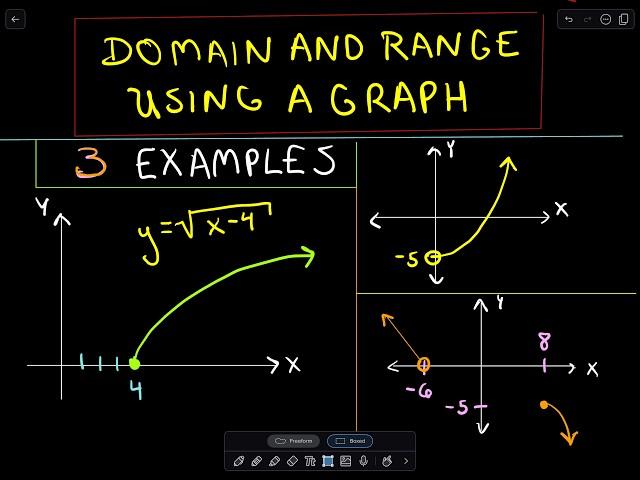
Domain and Range of a Function using a Graph
Комментарии:

Well, done!
Ответить
You made this complicated work looks so easy ...
Well done

Wow! This is the most useful kind of information I could have as a student. Great job keeping it simple and explaining it well.
Ответить
its all about touching
Ответить
this didnt help im so confused
Ответить
Thank you so much (-'8
Ответить
Thank you!
Ответить
This is perfectly described. Thank you for taking the time to make this video!
Ответить
I love you
Ответить
wow!....thank you so much.....it helped a lot...you are too good...
Ответить
Your range is wrong it should be -5, infinity
Ответить
😒 u are weird
Ответить
brilliant
Ответить
i love you
Ответить
Patrick how do you find range of function that has two square roots e.g f(x)= square root of (3-x) + square root of (x+1) ???
Ответить
The pen trick helped so much, thank you!!
Ответить
You're such a great teacher! Thanks so much!!!!
Ответить
Can I have a question sir? Is it okay no matter what arrangements you have between the domain you know like example instead of [8,infinity) can it also be written [infinity,8) or not? I'm sorry I'm a dumn
Ответить
thumbs up graph
Ответить
Finally i understand abt this topic 😭😭😭😭 thanks a lot
Ответить
Thank you this helped a lot
Ответить
Thank God this helps so much.I understand it now. My teacher makes things much more complicated, talking about a bunch of scenarios and long math terms and stuff but this is a lifesaver for me and my test soon
Ответить
Isnt it [8, -infinity)
Ответить
Why does he sound like Tim from Brainpop...
Ответить
Thank you for this!!
Ответить
what's with the parenthesis and brackets? pls tell me.
Ответить
is the last graph a union?
Ответить
Thank you so much you really helped me with the domain and range👍😍
Ответить
WTF...you sound like a slow version of a teacher on Charlie Brown. Seriously.
Ответить
ILY ❤️ for this video man
Ответить
767,767 views. Perfectly balanced, as all things should be
Ответить
OMG thank you for the "not touching" trick. I was so stumped over this until now. thanks.
Ответить
Thank you SO much.
Ответить
Is this the same with a straight line
Ответить
Thank you so much man this helped out a bunch
Ответить
Thank you so much
Ответить
IDK how I found you but you are saving my life right now!!
Ответить
really very helpful🥰sir
Ответить
whats the domain of the last graph?
Ответить
man this is old tho
Ответить
Thank you! You saved me!
Ответить
he's not even indian
Ответить
thxxxxxx
Ответить
I'm more confused now than when i began
Ответить
An open(or closed) circle then apply to both domain and range at that point? If so, if a function so defined that x can be between (5,10) has y value say 1 all over (constant function), I cannot simply use the open circle at either end ?? Would work for domain, but not for range!
Ответить
Here u see the RHS side of x axis as from here only the upward arrow begins so u include the zero in domainl
Ответить
Here we have written 4 as its the first place we hit the graph
Ответить






![Ugly Side Up - 10/9c - 3. Rockasm [Lava Lamp] Ugly Side Up - 10/9c - 3. Rockasm [Lava Lamp]](https://rtube.cc/img/upload/VXdBbGRSMC1vTWg.jpg)


















